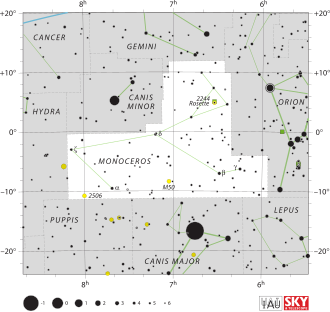HD 49434 is a single star in the equatorial constellation of Monoceros. It is faintly visible to the naked eye with an apparent visual magnitude of 5.75.[1] Based on parallax measurements the star is located at a distance of 130.5 light years from the Sun,[2] but it is drifting closer with a radial velocity of −17 km/s.[4]
| Observation data Epoch J2000.0 Equinox J2000.0 | |
|---|---|
| Constellation | Monoceros[1] |
| Right ascension | 06h 48m 19.066s[2] |
| Declination | −01° 19′ 08.12″[2] |
| Apparent magnitude (V) | 5.75[1] |
| Characteristics | |
| Spectral type | F1V[3] |
| B−V color index | 0.292±0.004[1] |
| Variable type | γ Dor/δ Sct hybrid[3] |
| Astrometry | |
| Radial velocity (Rv) | −17.2±0.2[4] km/s |
| Proper motion (μ) | RA: −37.120 mas/yr[2] Dec.: −35.061 mas/yr[2] |
| Parallax (π) | 24.9902 ± 0.0546 mas[2] |
| Distance | 130.5 ± 0.3 ly (40.02 ± 0.09 pc) |
| Absolute magnitude (MV) | 2.74[1] |
| Details | |
| Mass | 1.55±0.14[5] M☉ |
| Radius | 1.601±0.052[5] R☉ |
| Luminosity | 6.89[1] L☉ |
| Surface gravity (log g) | 4.43±0.20[5] cgs |
| Temperature | 7,632±126[5] K |
| Metallicity [Fe/H] | 0.33±0.04[1] dex |
| Rotational velocity (v sin i) | 85.7±4.3[6] km/s |
| Other designations | |
| Database references | |
| SIMBAD | data |

During a study with the ELODIE spectrograph from 1998 onwards it was found to show low amplitude variations of absorption line profiles, which is an indication of non-radial pulsations. It also displays a long period, low amplitude variation in luminosity, which together suggest it is a Gamma Doradus variable.[9] Observation of the star during the CoRoT mission showed ten pulsation frequencies, four of which are typical for Gamma Doradus variables and six higher frequencies that are characteristic of Delta Scuti variables. Hence it is classified as a hybrid pulsator.[3]
The spectrum of HD 49434 presents as an F-type main-sequence star with stellar classification of F1V.[3] It displays a high rotation rate with a projected rotational velocity of 86 km/s.[6] The star has 1.55 times the mass of the Sun and 1.60 times the Sun's radius.[5] It is radiating 7[1] times the luminosity of the Sun from its photosphere at an effective temperature of 7,632 K.[5]
References
edit- ^ a b c d e f g h Anderson, E.; Francis, Ch. (2012), "XHIP: An extended hipparcos compilation", Astronomy Letters, 38 (5): 331, arXiv:1108.4971, Bibcode:2012AstL...38..331A, doi:10.1134/S1063773712050015, S2CID 119257644.
- ^ a b c d e Brown, A. G. A.; et al. (Gaia collaboration) (2021). "Gaia Early Data Release 3: Summary of the contents and survey properties". Astronomy & Astrophysics. 649: A1. arXiv:2012.01533. Bibcode:2021A&A...649A...1G. doi:10.1051/0004-6361/202039657. S2CID 227254300. (Erratum: doi:10.1051/0004-6361/202039657e). Gaia EDR3 record for this source at VizieR.
- ^ a b c d Uytterhoeven, K.; et al. (October 2008), "The γ Doradus CoRoT target HD 49434. I. Results from the ground-based campaign", Astronomy and Astrophysics, 489 (3): 1213–1224, arXiv:0807.0904, Bibcode:2008A&A...489.1213U, doi:10.1051/0004-6361:200809992.
- ^ a b Gontcharov, G. A. (2006), "Pulkovo compilation of radial velocities for 35495 stars in a common system", Astronomy Letters, 32 (11): 759–771, arXiv:1606.08053, Bibcode:2006AstL...32..759G, doi:10.1134/S1063773706110065, S2CID 119231169.
- ^ a b c d e f Sánchez Arias, J. P.; et al. (January 2017), "Asteroseismology of hybrid δ Scuti-γ Doradus pulsating stars", Astronomy & Astrophysics, 597, id. A29, arXiv:1609.02864, Bibcode:2017A&A...597A..29S, doi:10.1051/0004-6361/201629126.
- ^ a b Ammler-von Eiff, M.; Reiners, A. (June 2012), "New measurements of rotation and differential rotation in A-F stars: are there two populations of differentially rotating stars?", Astronomy & Astrophysics, 542, id. A116, arXiv:1204.2459, Bibcode:2012A&A...542A.116A, doi:10.1051/0004-6361/201118724.
- ^ "HD 49434", SIMBAD, Centre de données astronomiques de Strasbourg, retrieved 2024-02-07.
- ^ "MAST: Barbara A. Mikulski Archive for Space Telescopes". Space Telescope Science Institute. Retrieved 14 September 2024.
- ^ Bruntt, H.; et al. (July 2002), "Abundance analysis of targets for the COROT/MONS asteroseismology missions. I. Semi-automatic abundance analysis of the gamma Dor star HD 49434", Astronomy and Astrophysics, 389: 345–354, arXiv:astro-ph/0203305, Bibcode:2002A&A...389..345B, doi:10.1051/0004-6361:20020549.
Further reading
edit- Brunsden, E.; et al. (March 2015), "The classification of frequencies in the γ Doradus/δ Scuti hybrid star HD 49434", Monthly Notices of the Royal Astronomical Society, 447 (3): 2970–2980, arXiv:1412.2828, Bibcode:2015MNRAS.447.2970B, doi:10.1093/mnras/stu2615.
- Chapellier, E.; et al. (January 2011), "The γ Doradus CoRoT target HD 49434. II. Frequency analysis of the CoRoT data", Astronomy and Astrophysics, 525, id. A23, Bibcode:2011A&A...525A..23C, doi:10.1051/0004-6361/201014207.
- Campante, T. L.; et al. (March 2010), Might intermediate-order g modes observed in the CoRoT hybrid gamma Doradus/delta Scuti star HD 49434 be stochastically excited?, arXiv:1003.4427, Bibcode:2010arXiv1003.4427C.
- HD 49434 FEROS spectroscopic time-series data release (v1.0), European Southern Observatory, August 6, 2010, retrieved 2024-02-08.
- Chapellier, E.; et al. (September 2009), "A Search of the Intrinsic Frequencies in the γ Dor COROT Target HD 49434", Stellar Pulsation: Challenges for Theory and Observation: Proceedings of the International Conference, AIP Conference Proceeding, vol. 1170, pp. 472–473, Bibcode:2009AIPC.1170..472C, doi:10.1063/1.3246545.
- Bouabid, M. -P.; et al. (December 2008), "Preliminary seismic study of the γ Doradus COROT target HD 49434", Communications in Asteroseismology, 157: 290–291, Bibcode:2008CoAst.157..290B.
